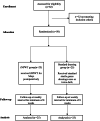Effectiveness of incisional negative pressure wound therapy after major lower extremity amputation: a randomised controlled trial
- PMID: 37435705
- PMCID: PMC11060853
- DOI: 10.1308/rcsann.2023.0011
Effectiveness of incisional negative pressure wound therapy after major lower extremity amputation: a randomised controlled trial
Abstract
Introduction: The aim was to study the effect of incisional negative pressure wound therapy (iNPWT) in wound healing compared with standard sterile gauze dressings after major lower extremity amputation in patients with peripheral arterial disease (PAD).
Methods: This prospective, randomised controlled trial included 50 patients undergoing major lower extremity amputations for PAD. Patients were randomised into iNPWT and standard dressing groups. The patency of blood vessels at the level of the stump was ensured with or without revascularisation. The primary outcome was wound-related complications such as surgical site infection (SSI), wound dehiscence, seroma/haematoma formation or the need for revision amputation. The secondary outcome was the time taken for the eligibility of prosthesis placement.
Results: It was found that only 12% of the patients in the iNPWT group had SSI compared with 36% in the standard dressing group (p = 0.047). Rates of wound dehiscence, seroma/haematoma formation and revision amputation were decreased in the iNPWT group but this was not statistically significant (p > 0.05). There was a significant reduction in the time taken for eligibility of prosthesis placement in the iNPWT group (5.12 ± 1.53 vs 6.8 ± 1.95 weeks, p = 0.002).
Conclusions: iNPWT is effective in reducing the incidence of SSI and the time taken for rehabilitation in patients undergoing major lower limb amputation due to PAD.
Keywords: Amputation; PAD; RCT; Stump dehiscence; Surgical site infection; iNPWT.
Figures
Similar articles
-
Closed incision negative pressure wound therapy may decrease wound complications in major lower extremity amputations.J Vasc Surg. 2021 Mar;73(3):1041-1047. doi: 10.1016/j.jvs.2020.07.061. Epub 2020 Jul 21. J Vasc Surg. 2021. PMID: 32707380
-
Incisional Negative Pressure Wound Therapy After Revascularisation Surgery in Patients with Peripheral Arterial Disease: A Randomised Trial (PICO-Vasc Study).Eur J Vasc Endovasc Surg. 2024 Aug;68(2):238-244. doi: 10.1016/j.ejvs.2024.04.031. Epub 2024 Apr 25. Eur J Vasc Endovasc Surg. 2024. PMID: 38677468 Clinical Trial.
-
Prophylactic Incisional Negative Pressure Wound Therapy Versus Standard Dressing after Major Lower Extremity Amputation: A Randomised Controlled Trial.Eur J Vasc Endovasc Surg. 2022 Nov;64(5):579-580. doi: 10.1016/j.ejvs.2022.07.057. Epub 2022 Aug 10. Eur J Vasc Endovasc Surg. 2022. PMID: 35961625 Clinical Trial. No abstract available.
-
Incisional Application of Negative Pressure for Nontraumatic Lower Extremity Amputations: A Review.Surg Technol Int. 2019 May 15;34:49-55. Surg Technol Int. 2019. PMID: 30472722 Review.
-
Incisional negative pressure wound therapy for clean-contaminated wounds in abdominal surgery: a systematic review and meta-analysis of randomized controlled trials.Expert Rev Gastroenterol Hepatol. 2021 Nov;15(11):1309-1318. doi: 10.1080/17474124.2021.1967143. Epub 2021 Aug 18. Expert Rev Gastroenterol Hepatol. 2021. PMID: 34384325
Cited by
-
The incidence of surgical site infection following major lower limb amputation: A systematic review.Int Wound J. 2024 Jul;21(7):e14946. doi: 10.1111/iwj.14946. Int Wound J. 2024. PMID: 38961561 Free PMC article.
References
-
- Van der Meij WKN. No leg to stand on. Historical relation between amputations. Surg Prostheseol 1995; 1: 1–256.
-
- Advanced Amputee Solutions. Amputee Statistics. https://advancedamputees.com/amputee-statistics-you-ought-know (cited April 2024).
-
- Norgren L, Hiatt WR, Dormandy JAet al. . The next 10 years in the management of peripheral artery disease: perspectives from the ‘PAD 2009’Conference. Eur J Vasc Endovasc Surg 2010; 40: 375–380. - PubMed
-
- Berridge DC, Slack RC, Hopkinson BR, Makin GS. A bacteriological survey of amputation wound sepsis. J Hosp Infect 1989; 13: 167–172. - PubMed
-
- Perkins P. Surgical wounds. Wound dehiscence: causes and care. Nurs Stand Spec Suppl 1992; 34: 12–14. - PubMed
Publication types
MeSH terms
LinkOut - more resources
Full Text Sources
Medical



